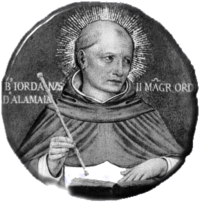Jordan of Saxony
| Blessed Jordan of Saxony, O.P. | |
|---|---|
|
| |
| Master General of the Order of Preachers | |
| Born |
ca. 1190 Borgberge near Dassel, Duchy of Saxony |
| Died |
13 February 1237 at sea, near Syria |
| Venerated in | Roman Catholic Church |
| Beatified | 1825 by Pope Leo XII (cultus confirmed) |
| Feast | 13[1] February |
| Patronage |
Vocations to the Dominican Order Faculty of Engineering University of Santo Tomas Manila, Philippines |
The Blessed Jordan of Saxony, O.P. (referred to in Latin as Jordanus, also known as de Alamania) (ca. 1190 – 1237), was one of the first leaders of the Dominican Order. His feast day is February 13.
Life
Jordan belonged to the noble German family of the Counts of Eberstein. He was born in the Castle of Borrenstrick, in the diocese of Paderborn. He began his studies in his native land, and was sent to complete them at the University of Paris.[2] While a student he met Dominic de Guzman, the founder of the Order of Preachers, and was inspired by the preaching of Reginald of Orleans to join the Dominican Order. He received the habit on Ash Wednesday, 1220. Jordan was a Master of Arts and a grammarian, and taught in the schools of Paris.[3]
In the summer of 1221, a General Chapter of the Order held in Bologna appointed Jordan Prior Provincial of Lombardy in Italy.[4]
Master General
On 6 August 1221, Dominic died, and Jordan was elected as his successor as Master General of the Order of Preachers.[2] Like Saint Dominic, Jordan was famed as a strict disciplinarian whose commitment to the Rule was tempered with kindness.
During Jordan's administration, the young Order increased to over 300 monasteries. Jordan is particularly remembered for his eloquence in attracting candidates to join the Order. Through his lectures in university towns, he won many—allegedly well over 1,000—professors and students for the Order from the universities of Europe, among whom was Albertus Magnus.[4] He added four new provinces to the eight already existing. Twice he obtained for the Order a chair at the University of Paris and helped to found the University of Toulouse. He established the first general house of studies of the Order.[5]
Additionally, Jordan was a spiritual guide to many, including one of the first Dominican nuns, the Blessed Diana degli Andalò, O.P.[2] He also found time to write a number of books: a life of St. Dominic and several other works. Among them was the Libellus de principiis Ordinis Praedicatorum ("Booklet on the beginnings of the Order of Preachers"), a Latin text which is both the earliest biography of Saint Dominic and the first narrative history of the foundation of the Order.
A section of a work by Friar Gerald de Frachet describing the lives of the first Dominicans, the Lives of the Brothers (Vitae fratrum), is dedicated to describing his character, virtue, and miracles. All of the first chroniclers of the Order describe Jordan's kindness and personal charm. He had the ability to console the troubled and to inspire the despondent with new hope.[6]
Death
Jordan died, at the age of forty-seven, in a shipwreck on his return from Palestine, where he was visiting the local monasteries of the Order. The shipwreck occurred off the coast of Syria on 13 February 1237.[4] Jordan was buried in the Dominican Church of St. John in Akko, in present-day Israel.
His feast day is 13 February. [7]
Veneration
Jordan of Saxony was beatified by Pope Leo XII in 1825.
Patronage
He is venerated as the patron of Dominican vocations. Jordan is honored as the patron saint of the Faculty of Engineering of the University of Santo Tomas, in Manila, which was founded by the Dominican Order.
Legacy
Jordan of Saxony is credited with introducing the practice of singing the Salve Regina in procession at the end of Compline, done, it is recorded, to calm the spirits of the Brothers, who were being tried by the Devil.[5]
References
- ↑ http://www.opne.org/Calendar.htm#February
- ↑ 2.0 2.1 2.2 "Blessed Jordan of Saxony, OP", The Dominicans, Province of the Most Holy Name of Jesus, February 13, 2012
- ↑ Jordan of Saxony, The Libellus, (Introduction), Our Lady of the Holy Rosary Province, OP
- ↑ 4.0 4.1 4.2 "Blessed Jordan of Saxony", Dominicans Interactive
- ↑ 5.0 5.1 "Bl. Jordan of Saxony". Dominican Sisters of St. Cecelia
- ↑ Dorcy OP, Mary Jean. "St. Dominic's Family", Tan Books, 1983
- ↑ http://www.opne.org/Calendar.htm#February
External links
| Preceded by Dominic de Guzman |
Master General of the Dominican Order 1222–1237 |
Succeeded by Raymundo de Peñafort |
|
